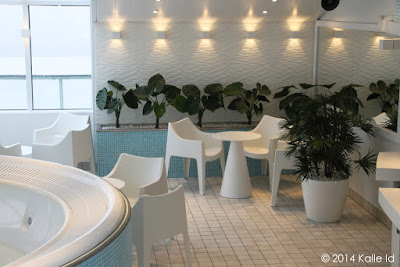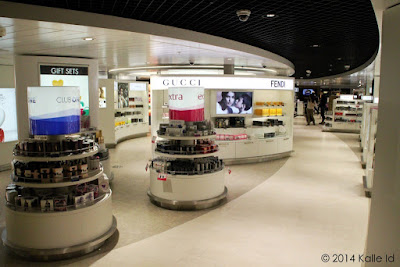I guess it's nescessary to start with the traditional apologies for the lack of updates recently. My goal was to update the blog once a week, starting from November, and there was a grand total of one entry in all of December. In addition to Christmas, I was busy working simultaneously with not just one but two issues of Ulkomatala (a Christmas special, which you can read from the
magazine's website - presuming that you speak Finnish - and the next proper issue, which will come out in two days). I'm not sure how regular updates will be in the future either, as I've received a research grant for a book on the history of Finnish shipbuilding
and I'm starting as a regular contributor with
Cruise Business Review. But weekly updates still remain the goal, and hopefully I'll also achive that somewhat more frequently.
Silja Serenade
IMO 8715259
Built 1990, Masa-Yards Turku New Shipyard, Finland
Tonnage 58 376 GT
Length 203,03 m
Width 31,93 m
Draught 7,12 m
Ice class 1A Super
2 852 passengers
3 001 berths
410 cars
1 600 lane metres
4 Wärtsilä-Vasa diesels, combined 32 580 kW
2 propellers
2 bow thrusters
1 stern thruster
Speed 21 knots
The
Silja Serenade was at Rauma last November for a few weeks being refitted. These photos are not from that particular refit, but rather taken after her February 2014 refit, which started the current renewal cycle for the
Silja Serenade and
Silja Symphony. I did not post these here immediately after the refit, as shots from the session were featured both in my 2014 book,
Silja Line from De Samseglande to Tallink, and in Ulkomatala. It's high time these get featured here, too. Most of the photos are of the refitted spaces and as such they are the current interiors of the ship.
All photos are from the press tour of the refitted ship on 17 February 2014. As per the usual, click on the images to see them in larger size.
Deck 13 houses the bridge as well as New York Club & Lounge, an observation lounge around the funnel.
Deck 12 has the main sun deck, and the Sunflower Oasis Sauna and pool complex around the base of the funnel.
 |
| Sunflower Oasis' pool area was one of the spaces completely refitted. Seen here is, according to the compamny, the largest jacuzzi on the Baltic. |
 |
| I have to say I find the new interiors a bit blad, too much white and not enough colour. Sure, the original had terrible plexiglass rocks, but also some quite nice streamline moderne -inspired furnishings and teak furniture - I kind of miss those. |
 |
| At least at the time the actual saunas, as well as the dressing rooms, were in original appearance. If I've understood correctly, the dressing rooms have since been rebuilt - which is a good thing, they rather clashed with the new look of the pool area. |
Deck 11 is dedicated exclusively to cabins.
Deck 10 houses a dedicated Commodore Class lounge forward, alongside more cabins. The
Silja Serenade was the second ship to introduce the "ship within a ship" class concept now popular wth cruise ships, and the first newbuilt ship to do so (the first was the
Finnjet after her 1986 refit).
 |
| The redecorated Commodore Lounge. This was the first time the area was given a proper makeover - so after 24 years it was high time! |
Deck 9 is, again, dedicated to cabins. Forward are three junior suites added in the 2014 refit, which replaced the conference suites previously located there.
 |
| If I remember correctly, the interior architect for the suites was Marjut Nousiainen. Each suite is themed; here is the bedroom of Spring... |
 |
| ...the sitting area of Summer... |
 |
| ...and the sitting area of Autumn. As you can see, the main differentiating factor is the colour of the upholstery and carpets. |
Deck 8 has the upper storey of the Atlantis Palace showlounge complex forward, followed by more cabins.
Deck 7 is the ship's heart, with the promenade (horizontal atrium) running through it, lined by shops, restaurants and bars. The forward half of the promenade was rebuilt in the 2014 refit, with the aft parts following in 2015.
 |
| View of the promenade from the entrance to Atlantis Palace, facing aft. |
 |
| The gift shop added in the 2014 refit. |
 |
| Kids & Toys replaced the previous Trend Shop in the 2014 refit. |
Deck 6 houses conference rooms forward, followed by the Tavolata Italian restaurant, the Tax Free Superstore and the Grande Buffet. Apart from the conference rooms, all spaces on this deck were rebuilt in the 2014 refit.
 |
| The conference area as it appeared in 2014. At least the conference lobby was completely rebuilt in the 2015 refit. I'm not sure if all conference rooms were given the same treatment. |
 |
| I admit my first reaction to Tavolata was "not another Italian restaurant!", but the food surprised me very pleasantly. As for the interiors... well, I like subtle use of the colours of the Italian flag, but it does lack that something. Now sure what, but something. |
 |
| The new Tax Free Superstore encompasses the old main tax-free shop, Orient Café and parts of Bistro Maxime. |
 |
| The crew were still hard at work putting everything in the correct locations when we were onboard, normally there aren't piles of cardboard boxes laying around. |
 |
| The new layout emulates that of airport duty free stores, which is a very nice change from the old grocery store -style layout. This is in part by nescessity, as the only route through deck six now passes through the tax free shop. |
 |
| The buffet restaurant, aft on deck six, was completely rebuilt. The entrance, seen here, has been opened up beautifully. |
 |
| The servery areas were rebuilt, but remain in the island-type arrangement, with the exception of the servery area for main courses. I'm somewhat surprised the latter wasn't extended, as it's long been the bottleneck of the whole space. |
 |
| While the new look of the sitting areas has been criticized, I really very much like the vibrant colours and simple forms. |
 |
| In fact, I like it so much that here's another photo. |
At the time of this visit,
Deck 5 housed a spa forward and cabins aft. In the 2015 refit, the spa was converted to a large children's playroom and ice cream bar.
Decks 3 & 4 house the ship's car deck and crew cabins.
Deck 2 has economy-class cabins forward and technical spaces aft.
Next time: probably the
Princess Anastasia.


































